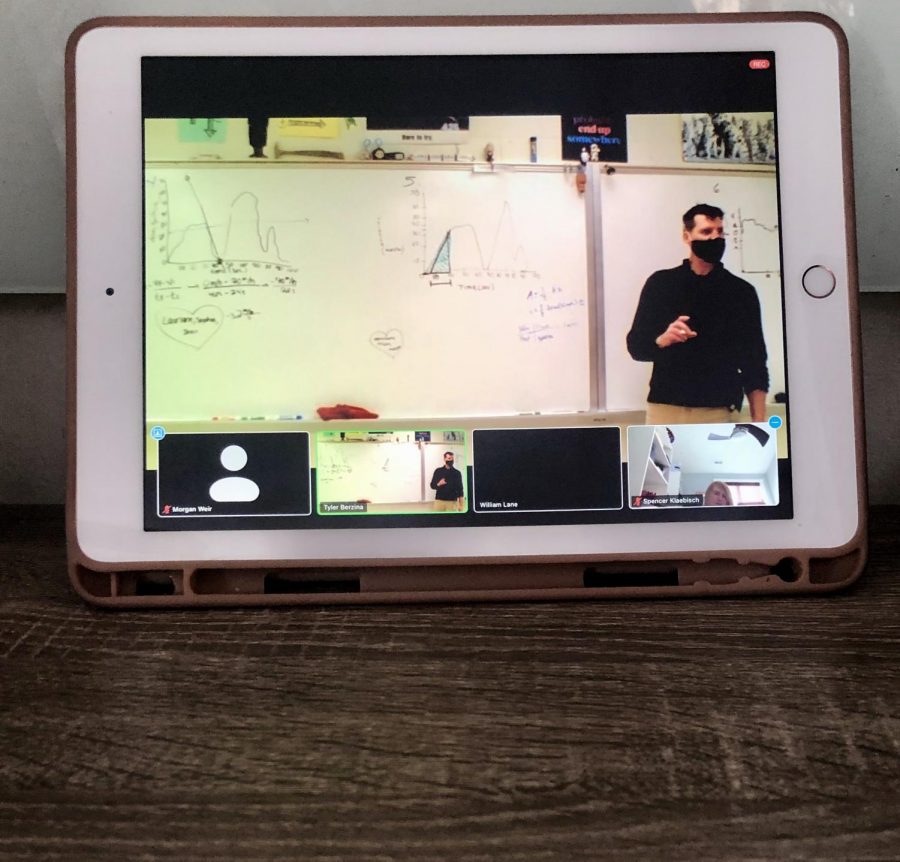The trials and tribulations of learning from home
Remote students find positives despite challenges
Remote students follow along with a physics lesson through Zoom. Teachers now have to divide their attention between in-person and remote students. “Remote has been a good option for some students with extenuating circumstances,” assistant principal Casey Lundgren said. “I’m glad we have been able to have it as an option this year. With that being said, this has added a tremendous burden to our teachers, who already have a very difficult job.”
February 22, 2021
Conversing through a chat function, taking tests over Zoom, learning entirely from home: what was once a science-fiction scenario is now the daily reality for Millard West’s remote learners.
When the district decided to return to 100% in-person school back in August, they gave students the option to do long-term remote learning. Currently, there are 183 students at Millard West who have chosen that option.
Some made the choice because they enjoy the flexibility that learning from home offers. Some did it out of concern for their personal safety amid an infectious novel virus that the world didn’t know much about. Others did it to protect at-risk family members.
“I chose to do remote learning because my dad has a rare form of asthma called Eosinophilic asthma,” junior Makaela Raumaker said. “This type of asthma over-produces white blood cells which can cause inflammation and swelling of the airways. I would not want to bring COVID-19 home to my dad because he would be at a very high risk for complications.”
Still others found themselves in unique circumstances that made returning to school in-person unsafe for the people around them.
“I went remote not only for my dad’s health but also because we own a restaurant,” junior Nicole Lin said. “If I were to contract the virus without knowing, I may spread it to both my family and customers via our family restaurant. If I were to quarantine myself, I wouldn’t be able to help run the restaurant, or we’d have to close down our store while we are quarantining.”
While remote learning has offered students a way to stay safe during the pandemic, it has come with a unique set of challenges. Internet issues, technology crashes, Zoom struggles and distractions at home are just a few common problems. Online learning also makes it difficult, and in some cases nearly impossible, for students to work collaboratively or participate in group activities.
“For me, the biggest challenge with remote learning has been being unable to participate in hands-on activities and real-time class discussions,” junior Russell Johnson said. “These types of activities have helped me to learn important concepts in the past, and I’ve missed the in-person experiences that can happen in the classroom.”
While in-person students are figuring out how to learn while social distancing and wearing masks, remote students are finding ways to manage their own time, advocate for themselves and self-motivate.
“The biggest challenge of remote learning is staying on task and resisting the temptation to slack off in class because of how easily available distractions are in my room, such as scrolling through my phone or watching Netflix instead of doing my homework,” senior Arabella Davis said. “Getting materials that are needed for classes is fairly difficult as well.”
Some online classes have proven to be more challenging than others. Hands-on subjects like art, music, gym or science are especially difficult to do from home. Still, remote students like senior Grace Hager, who is taking Lifetime Fitness this semester, have found silver linings.
“Taking a gym class online is a weird concept,” Hager said. “I do like it a lot better though. I’m able to do my workouts on my own time and pace. I’ve had COVID and my lungs haven’t been the same since, so being able to take a break when needed and not get penalized for it is great.”
Like Hager, Davis has found that even the most challenging and non-traditional online classes have their perks.
“I took Advanced Studio Arts in my first term,” Davis said. “I found it much easier to come up with my ideas for art because my personal experiences at home were the best pieces of inspiration I needed. I enjoyed working at home because I found it easier to focus on my work while watching my favorite TV show or listening to music.”
Even though learning from home can make it easier to get work done, social isolation and lack of connection are a constant struggle. For remote learners, there are no conversations with friends during lunch, no clubs or sports after school and no face-to-face interactions with peers. Digital communication has become critical for them. Emailing teachers, FaceTiming friends or Zooming with family are their main ways to stay connected.
“Social media, such as Instagram and Discord, have been absolute lifesavers for me,” Davis said. “The ability to connect with others within the safety of my home all because of the internet is something I am very thankful for. I still miss talking to my peers and other teachers in person, but it is a small price to pay for keeping my family COVID-free.”
Having to constantly use digital resources and technology to stay connected may be a pain, but it has helped remote students build on important skills. Sending emails, getting to class on time without bells and asking questions over Zoom have become necessities for success.
“I think that my organizational skills have improved significantly since I have been a remote learner, especially since most of the work I do for my classes is digital,” Johnson said. “This organization has helped me to be efficient with my time and has helped me a lot with remote learning.”
Students aren’t the only ones who are improving on their digital abilities because of remote learning. Teachers have had to adapt their classes and teaching styles. The combination of in-person and at-home learners has pushed them to come up with creative solutions, such as making alternate assignments for remote learners or having students at home FaceTime students in class to participate in group projects. Many of them are utilizing whatever technology they can to keep remote students engaged.
“I have really been forced to utilize the breakout room on Zoom,” social studies teacher Megan Mcenaney said. “When everyone was at home learning, I felt I could really tailor my lessons for digital learning. However, when I have only a few students learning at home, I try to make sure they still have an opportunity to engage with one another or those in the classroom in the same way as my in-person learners are doing. Therefore, I have tried to, even if it is only for a few minutes, send my remote learners into Breakout Rooms to discuss the same content as we are discussing in class.”
This extra effort from teachers has not gone unnoticed by remote learners. Whether it’s asking for feedback on how to improve their class, checking in throughout the block to see if anyone on Zoom has questions or staying close to the computer so that their voice is clearer, remote students value the little things that teachers do to make the process easier.
“I really appreciate it when the teacher makes an effort to connect with us and does their best to help us no matter if we are virtual or in person,” Lin said. “I really appreciate it when they type directions or information in the chat, just in case they think we missed it.”
During the pandemic, people have had to come together to find solutions and make things work, and remote learning is no exception; both teachers and students are working hard to deal with the inevitable challenges while still finding the positives.







